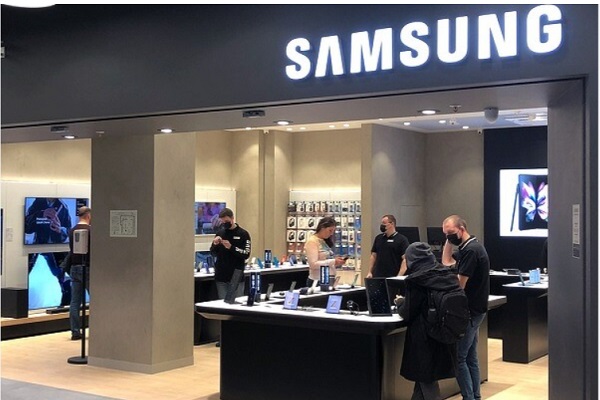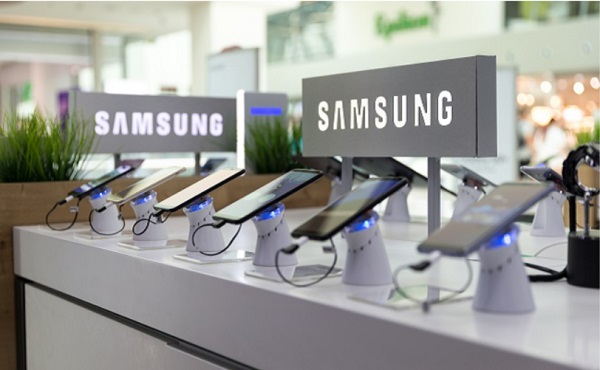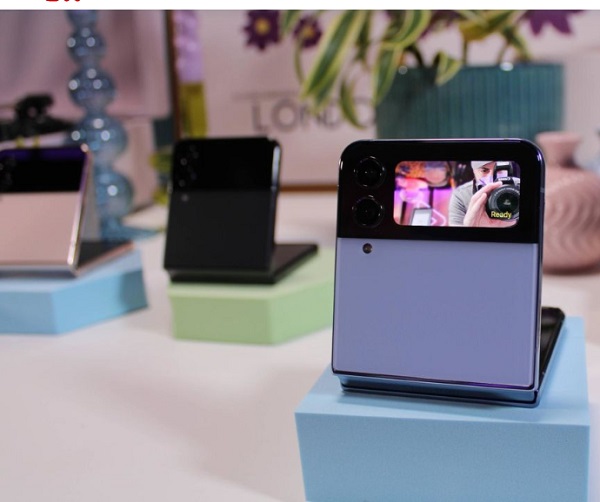Samsung Electronics has publicly apologized and recognized that the company is viewed as being in a “crisis” after announcing profit guidance that fell short of expectations on Tuesday.
The South Korean semiconductor leader reported a preliminary operating profit of ₩9.1 trillion ($6.8 billion) for the third quarter, which was below market predictions of ₩10.3 trillion, according to LSEG SmartEstimates.
Although its anticipated operating profit has nearly tripled from the same quarter last year due to a significant rise in memory chip prices, it represents a nearly 13 percent decrease from the second quarter of this year.
The company’s stock price has dropped nearly 30 percent over the past six months as worries grow regarding its ability to compete in advanced chips utilized in artificial intelligence systems.
“The leadership team at Samsung Electronics expresses its regret for not fulfilling your expectations regarding our performance,” Young Hyun Jun, the head of Samsung’s chip division, stated in a letter to customers, investors, and employees on Tuesday.
“We have raised concerns about our technical competitiveness, with some discussing the crisis facing Samsung. As the leaders of the business, we accept full responsibility for this,” said Jun, who assumed control of the division during a management reorganization in May.
The disappointing guidance announced on Tuesday highlights investor worries about worsening conditions in the memory market and the potential slowdown in AI investments by major tech companies, although some concerns were eased by Micron Technology’s recent positive outlook for the current quarter.
“Worries are mounting as demand for legacy memory is declining and smartphone sales are weaker than anticipated, while its entry into the advanced high-bandwidth memory (HBM) market is being delayed compared to competitors,” noted Kim Hyun-tae, an analyst at Shinhan Securities.
Concerns about the future of the industry have intensified after Morgan Stanley warned of an impending memory downturn, citing a decrease in demand for conventional DRAM memory and a possible oversupply of HBM.
“Conditions in the memory sector are starting to worsen,” analysts Shawn Kim and Duan Liu wrote in a recent report. “As we move past late-cycle conditions, revenue growth and margins will face increasing challenges.”
Macquarie analysts also cautioned about a possible oversupply in DRAM due to declining mobile and PC demand, predicting that Samsung might lose its leading position in the market.
Last week, Samsung shares fell to their lowest point in over 18 months, as the company has struggled to catch up with SK Hynix and Micron in providing the most cutting-edge HBM chips, a vital element of AI systems.

SK Hynix, the primary supplier of HBM chips to Nvidia, announced last month that it had commenced mass production of its 12-layer HBM3E chips, its most advanced iteration, thereby widening its technology gap with Samsung in this fast-evolving, high-margin sector. Reports indicate that Samsung’s HBM3E chips have yet to receive qualification from industry leader Nvidia.
“Delayed entry with HBM3E into Nvidia is resulting in a significant loss of market opportunity,” remarked Daniel Kim and Jayden Son, analysts at Macquarie, in a recent report. “Increasing production yield is another hurdle, even after achieving product qualification.”
Samsung is also facing difficulties in closing the gap with Taiwan Semiconductor Manufacturing Co in contract chipmaking, where it is projected to incur billions of dollars in losses this year. Analysts at Macquarie warned that Samsung’s $17 billion foundry in Taylor, Texas, could become a “big stranded asset” due to a shortage of major clients.
Samsung has indicated that production at the Taylor fab is set to begin in 2026 for cutting-edge chips at 4 nm and smaller, in order to address the rising demand from customers for advanced nodes amid the AI boom.
Intensified competition in the high-end smartphone sector raises additional concerns. Huawei introduced a $2,800 tri-fold phone last month to compete with Samsung, while Apple unveiled the new iPhone 16 last month, which offers a consistent stream of new generative AI features.
The poor guidance arrives as Samsung is reducing its workforce of 147,000 overseas employees and facing growing discontent among workers at home. The company has stated that its international subsidiaries are “making routine workforce adjustments to enhance operational efficiency.”
“Our main priority will be to improve our fundamental technological competitiveness,” Jun wrote, acknowledging the “testing times” the company is experiencing. “We will evaluate our organizational culture and processes and take prompt action to address any areas needing enhancement.”
Samsung Electronics, a major player in the smartphone and semiconductor markets, is reported to be implementing budget cuts, reducing its workforce, and scaling back celebratory events as it falls behind its global competitors in crucial product areas.
On Wednesday, Bloomberg reported that Samsung Electronics is anticipated to reduce approximately 10 percent of its total overseas workforce of 147,000, with the current layoffs taking place at its headquarters in Southeast Asia, Australia, and New Zealand.
The company had previously cut about 10 percent of positions in India and certain regions of Latin America, and it is projected to further decrease headcounts in additional overseas subsidiaries, according to insider sources cited by the news outlet.
More than half of the company’s total employees, which exceed 267,800, are made up of overseas staff
Amid recent staffing reductions, Samsung has stated that its workforce adjustments are merely part of its “routine activity.”
“A number of overseas subsidiaries are undertaking routine workforce adjustments to enhance operational efficiency,” a Samsung representative stated. “The company has not established a target number for any specific roles.”
Industry analysts perceive that the tech giant is tightening its budget due to a decline in performance in its primary products, such as memory chips and home appliances.
In the context of the AI boom, Samsung, which holds the title of the largest memory chip supplier globally, increased its investments in AI chip production, only to lag several months behind its close competitor SK hynix. In the growing High Bandwidth Memory chip sector, Samsung is struggling to keep pace with SK hynix, which announced the mass production of the latest 12-layer HBM3E chip last month.
The HBM chips are becoming essential components for graphic processing units that support advanced AI models and have been increasing their market share in the global DRAM industry, fueled by rising demand and the growth of Nvidia, the world’s leading GPU producer.
Due to a severe downturn in the global semiconductor sector, Samsung’s chip division saw the largest operating profit loss of 14.9 trillion won ($11.3 billion) in 2023, resulting in the company’s overall operating profit dropping to 6.54 trillion won — the lowest figure in 15 years.
With growing competition in the global smartphone market, Samsung is also experiencing unsatisfactory sales for its recently launched foldable smartphones, the Galaxy Z Fold 6 and Galaxy Z Flip 6, which debuted in July.
Sales for Samsung’s home appliances are also declining. During the April-June period, the company reported an operating profit of 490 billion won, marking a 34 percent decrease year-on-year.
Reflecting the prevailing crisis sentiment, Samsung’s shares temporarily fell to 59,900 won, reaching a new 52-week low on Wednesday. The stock rebounded to 61,500 won by the afternoon.
Market analysts are revising down Samsung’s earnings outlook for the July-September period. Market intelligence firm Yonhap Infomax gathered assessments from 16 securities firms last month, estimating Samsung’s operating profit for the third quarter to be 10.4 trillion won.
This figure is lower than the earlier forecast of 14 trillion won, with securities firms recently revising their expectations downward. iM Securities had initially projected an operating profit of 14.6 trillion won for Q3 but revised it to 11.2 trillion won, representing a reduction of 23.3 percent. KB Securities anticipates 9.7 trillion won, while Korea Investment & Securities estimates 10.3 trillion won.
Samsung Electronics appears to be postponing or scaling back upcoming events in an effort to reduce expenditures. The company has canceled an event celebrating the 50th anniversary of its semiconductor business that was scheduled for the end of this year. Additionally, its Global Foundry Forum, initially set to occur in Europe, China, and Japan in the latter half of this year, has been transformed into online events.
“Reducing costs is one strategy to mitigate risks in challenging times. However, it is crucial for company leadership to communicate a strong message on how they will tackle the current difficulties and develop a long-term strategy to sustain growth,” remarked an industry official.
Samsung is adopting an assertive stance toward its products and offerings, continuously striving to enhance its technology for better competition in the smartphone market. The company is reportedly considering a new branding strategy that could signify a considerable shift from its traditional approach. It is contemplating distancing itself from the Galaxy branding for its flagship smartphones, which has been in place since 2009, to forge a unique identity.

Samsung may discontinue its Galaxy branding for its high-end smartphones as it seeks to refresh its brand image
Traditionally, Samsung’s Galaxy series has been synonymous with its premium offerings. However, in the past year, competition has grown fiercer. This year, the array of products did not make a significant impact on users, who expressed disappointment over the lack of innovation in the Galaxy Z Fold 6 and Z Flip 6 models released in July.
The South Korean technology giant acknowledged its shortcomings and even apologized, initiating the development of new products to compensate. It appears that the company intends to go further in revitalizing its brand, as a report from E-Today, shared by a South Korean outlet, indicated that Samsung is contemplating removing the Galaxy branding from its high-end smartphones, likely including the S-series and Z-series.
Samsung’s updated branding strategy aims to enhance the premium perception of its top-tier devices and better position them against Apple and Google’s flagship offerings. This trend is not exclusive to Samsung, as other brands are also striving to enhance their high-end products to cultivate a more luxurious brand identity, especially for their premium models.
The report suggests that discussions about shifting in a new direction have been ongoing within the company for the past year. The Head of Global Marketing at Samsung, Lee Young-hee, at CES 2024, stated:
The Galaxy brand encompasses numerous lineups, and I understand that people are anticipating a new name with an innovative breakthrough.
Given the wide range of devices associated with the Galaxy branding, this move could be crucial for distinguishing the premium products. While many factors will need consideration before implementing this change, it could prove to be transformative for the company.
Samsung employees are increasingly looking to other companies
The situation at Samsung has deteriorated significantly, as employees are actively seeking opportunities outside of the company’s foundry sector. Following the release of its Q3 2024 earnings forecast and an apology regarding its underwhelming performance, various troubling reports have emerged, including that around 200 engineers applied to SK hynix for positions requiring experienced workers.
SK hynix had openings for only three positions; additionally, Samsung engineers with limited experience in the foundry sector are also trying to transfer.
Despite Samsung reportedly reducing the number of executives in its semiconductor division to enhance financial stability, The Elec suggests that employee morale is at a record low. SK hynix, a competitor of Samsung, recently secured NVIDIA as a customer for its HBM memory, a vital component for the mass production of AI GPUs. Recent reports indicate that SK hynix has posted job openings for which they sought three experienced etching engineers.
In a surprising turn, about 200 engineers from Samsung applied for that position, indicating that many of them qualify for the roles. The report also notes that it’s quite unusual for such a large number of Samsung employees to apply for a single position, hinting that these individuals are actively trying to progress their careers elsewhere. Those with less experience are also attempting to move to SK hynix, which has a recruitment program for engineers with fewer than five years of experience.
Last month, a town hall meeting took place with Samsung executives and employees in attendance. During the meeting, one individual inquired about strategies to retain current talent. The head of Samsung’s memory division, Lee Jung-bae, did not deliver an optimistic reply, telling the teams to put in the effort to dissuade others from seeking opportunities elsewhere. Regarding compensation, Samsung offers only marginally higher salaries than its competitors when including bonuses, providing even less incentive for employees to remain.
Employees at Samsung Electronics contend that the semiconductor division is “in crisis,” citing poor management and escalating competition.
According to staff, Samsung’s market performance stems from executives prioritizing short-term objectives.
The tech giant from Korea is clearly struggling to find its footing in the sector, whether regarding its semiconductor division or its efforts in the HBM market.
Samsung’s quarterly results have not met expectations, and the company has even apologized publicly for its declining business, indicating that it is indeed facing challenges in the industry.
A survey conducted by a YouTuber (through BusinessKorea) featuring current and former Samsung employees has underscored that the company is indeed facing a crisis, with respondents linking the situation to Samsung’s management.
The YouTuber conducting the survey currently works at Qualcomm and has previously worked at Samsung.
The survey included 24 current and seven former employees who stated that rising competition and the ineffective business decisions of the Korean giant contributed to a crisis, leading to a tough economic period for the company.
Out of those surveyed, 71% said that Samsung’s pace of technological innovation is significantly lagging compared to its rivals, asserting that senior executives are concentrating on short-term objectives.
Executives concentrate on yearly short-term goals and fail to grasp the broader picture.
The competitiveness of the actual products declines because leaders are preoccupied with meeting management by objectives for their respective departments.
There were numerous instances where I questioned if they would make such choices if they owned the company.

Samsung Employees via BusinessKorea
In addition to market performance, employees expressed that the corporate workplace is not conducive to progressive growth, noting that the company’s approach to its workforce is flawed, making internal communication challenging.
Some employees believe that Samsung is not offering sufficient compensation packages, even though it has higher operating profits than SK Hynix, which has demoralized the staff and ultimately stifled innovation and development.
When asked for possible solutions, employees suggested that Samsung should enhance its compensation packages and shift its focus toward long-term growth instead of being caught up in the rush to outpace its competitors in a shorter timeframe.
Despite the survey findings, it is clear that Samsung is facing significant difficulties, particularly as the company has failed to capitalize on opportunities, such as securing NVIDIA as an HBM client.
These factors affect the company’s sustainability and long-term business prospects, ultimately providing competitors with an advantage.
According to reports in the Korean press, Samsung Electronics’ chip manufacturing division is set to fall behind TSMC in revenue once it shares its third quarter earnings.
This will represent a stark contrast to the second quarter results, during which a recovery in the global memory market propelled Samsung’s chip manufacturing sector, known as the Device Solutions division, to the forefront of the global foundry landscape.
Korean analysts anticipate that Samsung DS’ revenue for the third quarter will not show sequential growth, while TSMC’s Q3 revenue improved by 12.9% from the previous quarter, allowing it to surpass Samsung in net sales.
Market observers believe that Samsung’s chip manufacturing revenue will remain stable without sequential growth in Q3.
Earlier this month, Samsung presented its preliminary earnings results for the third quarter and projected a midpoint of KRW79 trillion in sales, equivalent to $57.7 billion.
If this target is reached, it would indicate a robust 17.2% annual growth for the company, whose second quarter results provided a refreshing boost.
During Q2, Samsung reported KRW74 trillion in revenue, with its Device Solutions sector generating KRW28.56 trillion.
This amounts to approximately $21 billion, allowing Samsung DS to exceed TSMC’s revenue for the same timeframe. In Q2, TSMC generated $20.82 billion in revenue, reflecting a remarkable 30.8% year-over-year growth that indicated a recovery for the company after facing challenges in the chip industry during the immediate aftermath of the pandemic.
Samsung cited robust demand for memory products as the reason behind its revenue increase, even as these products had faced difficulties throughout 2023. This resulted in Samsung’s revenue declining by 37.5% on an annual basis, based on Gartner’s data. This situation also caused the struggling chip giant Intel to claim the title of the world’s largest chip manufacturer by revenue.
Nevertheless, Samsung’s advantage may be fleeting if the estimates reported by The Korea Herald prove accurate. The publication suggests that industry analysts in Korea expect Samsung’s DS revenue to remain unchanged in Q2. As a result, with TSMC’s Q3 revenue projected at $23.5 billion, if Samsung DS does not increase its revenue in Q3 compared to Q2, TSMC will surpass Samsung’s $21 billion sales by a significant margin of $2.5 billion.
While both companies produce semiconductors, TSMC specializes in CPUs and GPUs, or logic chips, whereas Samsung has a diversified business that also includes memory products. Samsung DS is split into three main divisions: Memory, Samsung LSI, and Samsung Foundry. Samsung LSI handles the production of Samsung’s Exynos processors and ISOCELL image sensors, while Samsung Foundry focuses on contract chip manufacturing.
However, both divisions have faced challenges as NVIDIA primarily depends on TSMC for its AI GPUs, and a downturn in global smartphone demand has led to fewer shipments from Samsung LSI. Consequently, the Herald’s sources also claim that the two business units experienced a deficit of KRW1 trillion during Q3. Additionally, Samsung has struggled to convince NVIDIA to utilize its advanced memory products, which continue to rely on the cutting-edge HBM3 and HBM3e memory offerings from the US memory leader Micron.
While TSMC’s advanced manufacturing technology (using 7 nanometer processes and smaller) increased by eight percentage points to account for 67% of its revenue in Q4 2023, Samsung Foundry saw a 1.9% sequential decline, totaling $3.62 billion.
Samsung Electronics disclosed on Thursday that its sales and operating profit for the third quarter slightly surpassed expectations, although its chip division witnessed a considerable decline in profitability compared to the prior quarter. The semiconductor segment reported an operating profit of 3.86 trillion won (around $2.8 billion) in the third quarter, representing a 40% drop from the previous quarter.
Despite strong demand for both artificial intelligence and traditional server products in the memory chip sector, Samsung noted that “inventory adjustments” adversely affected mobile demand and pointed to challenges stemming from “the increasing supply of legacy products in China.” Fueled by artificial intelligence, Samsung’s foundry unit experienced a notable rise in demand for advanced nodes; however, the company indicated that demand for mobile and PC products did not meet expectations.
Samsung acknowledged that the rebound in mobile and PC demand is expected to be delayed, despite an anticipated increase in interest for more advanced products driven by investments in AI. The results for the third quarter were slightly better than Samsung’s previous guidance given earlier this month, with revenues reaching 79.1 trillion won as opposed to the expected 79 trillion, and operating profit at 9.18 trillion compared to the projected 9.1 trillion won.
The guidance figures were significantly lower than LSEG’s forecast of 11.456 trillion won in operating profit. In an atypical move, Samsung’s Vice Chairman Jun Young-hyun, who now oversees the company’s device solutions division, extended a rare apology following the guidance release.
Looking ahead, Samsung expects that sustained demand for advanced chipsets will propel growth in the upcoming year. The company also predicts strong server demand as technology firms continue to make considerable investments. Meanwhile, shares of Samsung Electronics have fallen by 24.71% since the start of the year on the South Korean stock exchange.
On Thursday, South Korea’s Samsung Electronics announced a year-on-year operating profit increase of 277% to $6.6 billion, but it fell short of expectations as the company struggled to capitalize on the demand for chips utilized in artificial intelligence servers.
The largest memory chip manufacturer in the world reported an operating profit of 9.18 trillion won ($6.6 billion), “mainly due to one-off costs.”
It also cautioned in a statement that “the strength of the Korean won against the U.S. dollar had a negative impact on the overall operating profit.”
Although the operating profit nearly tripled compared to the previous year, it did not meet market expectations and decreased by 12% from the prior quarter.
Revenue increased by 17.35% to 79.1 trillion won ($57.2 billion), marking its highest quarterly figure, according to Samsung.
The firm is the flagship subsidiary of the South Korean conglomerate Samsung Group, which is by far the largest among the family-controlled conglomerates dominating business in Asia’s fourth-largest economy.
Semiconductors are essential to the global economy, used in a wide array of products including kitchen appliances, mobile phones, vehicles, and military equipment.
The semiconductor division of the company reported an operating profit of 3.86 trillion won, experiencing a sharp 40% decline compared to the previous quarter.
Samsung stated that its performance was impacted by “a reduced reversal of inventory valuation loss compared to the last quarter, one-off expenses such as the provision of incentives, and currency effects resulting from a weak dollar.”
Rare apology
Samsung has been trailing behind South Korean rival SK Hynix in the production of high bandwidth memory (HBM) chips that are critical for AI chipsets, which experts attribute to the company’s lackluster performance.
This month, Samsung management issued an unusual, separate apology, acknowledging that the company is experiencing a “crisis.”
“Due to results that did not meet market expectations, concerns have arisen regarding our core technological competitiveness and the future of the company,” stated the declaration, signed by Jun Young-hyun, the vice chairman of the company’s device solutions division.
“Our management will take responsibility in overcoming this crisis… We will transform the serious situation we are currently facing into an opportunity for a resurgence.”
Samsung shares have significantly declined by 33% since their peak in July, and the company has seen its market value shrink by more than $120 billion during this period.
Samsung’s shares increased by 0.3% in early trading in Seoul on Thursday.
This unusual apology followed approximately a week after the technology giant announced plans to reduce its workforce in some Asian operations, referring to this action as “routine workforce adjustments.”
According to Bloomberg, these layoffs might impact nearly 10% of the workforce in those regions.
Three sources with direct knowledge informed Reuters that Samsung Electronics, the leading global manufacturer of smartphones, televisions, and memory chips, is planning to cut up to 30% of its overseas personnel in select divisions.
The South Korea-based company has directed its worldwide subsidiaries to decrease sales and marketing staff by about 15%, while reducing administrative staff by as much as 30%, according to two of the sources.
This strategy is set to be implemented by the end of the year and will affect jobs across the Americas, Europe, Asia, and Africa, as stated by one individual. Six other people familiar with the situation also verified Samsung’s intended global workforce reduction.
It remains uncertain how many individuals will be laid off and which countries and business sectors will be most impacted. The sources wished to remain anonymous due to the confidentiality surrounding the job cuts’ scope and details.
In a statement, Samsung clarified that the workforce reductions occurring in certain overseas operations are standard procedure and intended to enhance efficiency. They also noted that there are no specific goals for these plans and that they do not involve their production staff.
As of the end of 2023, Samsung had a total of 267,800 employees, with over half, or 147,000, located overseas, according to its most recent sustainability report. Most of these jobs are in manufacturing and development, while around 25,100 are in sales and marketing, and approximately 27,800 are in other sectors, as indicated in the report.
The “global directive” regarding job cuts was issued roughly three weeks ago, and sources noted that Samsung’s operation in India had already begun offering severance packages to certain mid-level employees who have recently departed.
The total number of employees needing to exit the India unit could potentially reach 1,000, according to the source. Samsung has around 25,000 employees in India.
In China, a South Korean newspaper reported that Samsung has informed its employees about the layoffs expected to affect about 30% of its sales workforce.
SIGNIFICANT CHALLENGES
These job reductions emerge as Samsung faces increasing challenges in its primary business sectors. The company’s core chip division has been slower to bounce back compared to its competitors, leading its profits to sink to a 15-year low last year.
In May, Samsung appointed a new leader for its semiconductor division to address a “chip crisis” as the company tries to compete more effectively with its smaller rival SK Hynix in supplying high-end memory chips utilized in artificial intelligence technologies.
Samsung is encountering fierce competition in the high-end smartphone market from Apple and China’s Huawei, while it has consistently lagged behind TSMC in contract chip manufacturing. Additionally, in India, where Samsung generates around $12 billion in annual revenue, a wage strike is causing disruptions in production.
One source familiar with the job cut plans indicated they are being implemented in anticipation of a decline in global demand for technology products due to a slowing world economy. Another source mentioned that Samsung aims to bolster its financial performance by cutting costs.
It is currently unclear whether Samsung will also eliminate jobs at its headquarters in South Korea. One source noted that layoffs in South Korea would be challenging due to the politically sensitive nature of the issue. The Samsung Group, of which the electronics division is a key component, is the largest employer in the country and plays a crucial role in its economy.
Job reductions could also provoke labor unrest domestically. A labor union representing workers at Samsung Electronics recently staged a strike lasting several days, advocating for increased wages and benefits.
On Wednesday, shares of Samsung Electronics, South Korea’s most valuable stock, hit their lowest point in 16 months, as several analysts recently lowered their profit projections for the company, citing a sluggish recovery in demand for smartphones and personal computing devices.
Samsung’s revenue for the quarter that concluded in June increased by 23.42% compared to the same period last year, while operating profit skyrocketed by 1,458.2%.
The South Korean powerhouse attributed its strong performance to solid demand for both high-bandwidth and conventional memory, such as standard dynamic random access memory, from clients investing in AI.
For the latter half of the year, Samsung anticipates sustained strong demand from server AI for products like HBM, server DRAM, and SSDs. SSD, which stands for solid-state drive, is a storage device based on semiconductors.
The company noted that increasing capacity to satisfy the demand for HBM and server DRAM could lead to a tighter supply of conventional memory chips.
During its earnings presentation, the company stated that it aims to meet AI demand by boosting sales of HBM3E—the latest memory product designed for AI—through capacity enhancements in the second half of the year.
It will also elevate SSD sales, which are currently in high demand for AI servers.
Additionally, the firm announced it would distribute a dividend of 361 won per common and preferred share for the second quarter.
“Per our current dividend strategy, the total amount disbursed each quarter is approximately 2.45 trillion won, which will be distributed toward the end of August.”
Samsung’s stock rose by as much as 1.35% on Wednesday morning.
Memory momentum
HBM memory chips are essential for AI chips, which have experienced substantial demand driven by the AI boom. This trend has significantly benefited companies like Samsung Electronics and SK Hynix, the top two memory chip manufacturers globally.
“With average selling prices for memory expected to keep rising over the next few quarters, we predict quarterly profit growth for Samsung Electronics to continue until 2025,” CLSA mentioned in a report earlier this month following Samsung’s second-quarter projections.
The largest memory chip manufacturer in the world saw a rebound in business as memory chip prices recovered due to AI optimism last year. The South Korean electronics giant experienced record losses in 2023 as the industry struggled from a post-Covid decline in the demand for memory chips and electronic devices.
“Following announcements from Nvidia and global chip manufacturers about an AI semiconductor roadmap recently, we anticipate a trend of increasing memory prices until 1H25. We attribute this to heightened concerns regarding memory supply in light of robust demand for HBM and high-density enterprise SSD, which require more wafers and have longer production lead times,” SK Kim from Daiwa Capital Markets stated in a report last month.
Samsung has reportedly succeeded in testing its HBM3 chips for use in Nvidia processors for the Chinese market. So far, SK Hynix has led the HBM memory chip market, having been the exclusive supplier of HBM3 chips to Nvidia.
On Thursday, SK Hynix reported its highest quarterly profit since the second quarter of 2018, recovering from a loss of 2.88 trillion won in the same quarter a year prior.
Weaker smartphone demand
Smartphone sales fell in the second quarter mainly due to the “base effect of new model launches” in the first quarter. However, Samsung noted that the Galaxy S24 series continued to enjoy strong demand.
“The demand for smartphones decreased sequentially in this seasonally weaker quarter, especially in the premium category,” the company stated, adding that it expects growth in the premium segment in the second half although the mass market may experience a slowdown.
Profitability in the smartphone division also declined as the costs of essential components rose.
The company intends to persist in promoting its premium Galaxy AI products. Recently, Samsung announced the global availability of its latest Galaxy devices, including the Galaxy Z Fold6, Z Flip6, Watch Ultra, and Ring.
“Even amidst challenging conditions, we will keep investing in enhancing Galaxy AI capabilities to secure a sustainable growth engine in the long term,” Samsung declared on Wednesday.
Counterpoint Research indicated that Samsung should witness an “improved operational performance” in the second half, mainly driven by memory chips and a trend towards “premiumization” in smartphones.
“SK Hynix and Micron, however, will continue to challenge Samsung in memory, particularly in the AI sector with HBM growth, as well as in the AI smartphone and PC markets due to their close partnerships and optimizations with key computing players like Qualcomm, Intel, and Nvidia,” Neil Shah, research vice president at Counterpoint Research, commented in an email to CNBC.
Apple has increased its advantage over Samsung in India’s mobile phone sector, despite shipping less than half the number of devices compared to its South Korean competitor. The American tech company accomplished this through record-high average selling prices (ASPs) and strategic market growth, as reported by The Economic Times, referencing research from IDC.
In the first half of 2024, Apple delivered 4.8 million iPhones to India, bringing in $4.56 billion in revenue. In comparison, Samsung shipped almost twice the number of units at 9.8 million but generated $3.43 billion, trailing Apple by $1.13 billion in revenue. This represents a notable increase in the revenue gap compared to 2023, when Apple first surpassed Samsung’s mobile phone value share in India by a margin of only $362 million.
In 2023, Apple’s revenue in India amounted to $8.69 billion from 9.2 million units, while Samsung reported $8.33 billion. The gap has since expanded as Samsung’s performance in 2024 has been hindered by a 15 percent year-on-year decrease in shipments for the April-June quarter and a fall in ASPs from $380 to $313 in the second quarter of 2024.
“Samsung’s decline can be traced back to a substantial decrease in shipments and ASPs during April to June,” explained Navkender Singh, associate vice-president at IDC. “It also underperformed in the super-premium $700+ segment, where the recently launched Galaxy S24 did not perform as well as the previous quarter [January-March].”
Though Samsung asserts that it has maintained or grown its value share in the Indian market, IDC data tells a different story. In the first half of 2024, Apple’s value share reached 25.9 percent, up from 23 percent in 2023, while Samsung’s share dropped to 19.4 percent from 22 percent. Counterpoint Research, however, provided a slightly different perspective, estimating Samsung’s value share at 24.5 percent for the April-June timeframe compared to Apple’s 18 percent.
Analysts anticipate that Apple will conclude the year with around 12.5 million shipments in India, an increase from 9.2 million in 2023. Samsung’s shipments are projected to decline to roughly 20 million units, down from 24.7 million in 2023. This trend indicates that Apple’s revenue will likely continue to rise, supported by ASPs expected to remain more than three times higher than those of Samsung. Samsung’s financial results will largely hinge on the upcoming festive season.
For FY23, Samsung India reported revenues of Rs 98,924 crore, with mobile phones accounting for Rs 70,292 crore, according to data from the Registrar of Companies. In contrast, Apple India’s revenue for the same period was Rs 49,321 crore, with 94.6 percent originating from product sales, primarily iPhones.
While Samsung was the leading smartphone brand in India by volume in 2023, its prominence has diminished in recent quarters. The company faces intensifying competition in the lower-priced, high-volume segments from Chinese brands like Xiaomi and Vivo, which are bolstering their budget offerings with 5G capabilities. At the same time, Samsung is facing challenges in the high-end market due to Apple’s vigorous marketing and expanding local manufacturing, which aligns with the rising trend of premiumisation in India.
In the June quarter, Apple led in both the $600-800 premium category and the $800-plus super-premium segment, capturing 61 percent and 83 percent of shipments, respectively. In contrast, Samsung held a 21 percent and a 16 percent market share in these segments, according to IDC.
Despite a 53.6 percent revenue increase over the last five years, fueled by rising ASPs from $176 in 2019 to $338 in 2023, Samsung has experienced a 20 percent decline in shipment volumes during that same timeframe.
Samsung Electronics today organized the Silicon Valley Future Wireless Summit in Mountain View, California, under the theme “Future Wireless for the AI Era.”
After the 3rd Generation Partnership Project (3GPP) announced 5G-Advanced standards in March, there is a growing expectation for the integration of AI technology within the telecommunications sector. In particular, as the preparation for 6G communications escalates, the interest in next-generation communication technologies that leverage AI is on the rise.
In this context, Samsung Electronics arranged the Silicon Valley Future Wireless Summit to convey the vision and potential that AI-enhanced communication systems can bring.
Around 80 esteemed participants attended the event, including representatives from leading telecommunications companies, manufacturers, government bodies, and academia from various countries, who took part in extensive discussions regarding the future of research and technologies concerning AI-native communications.
“Since the launch of 5G, the telecommunications industry has increasingly prioritized enhancing user experience alongside performance upgrades through innovative solutions like AI and energy efficiency improvements,” stated Angelo Jeongho Park, Vice President of Samsung Research’s Advanced Communications Research Center. “This summit marks the beginning of our mission to help industry and academic leaders collaborate and further the crucial research already underway on the integration of AI and wireless communication technologies, elevating the user experience.”
Sharing Insights on AI-Native Communication Technology: The Future Direction of Communication Research
The summit opened with a keynote address from industry specialists titled, “Shaping the Future of Next Generation Mobile Communication,” followed by three primary sessions: “AI-Native Communication,” “Sustainability: Energy Saving & Efficiency,” and “Innovations to Drive Future Wireless.” Each session fostered dynamic discourse among participants through Q&A segments and vigorous debates.
In the “AI-Native Communication” session, participants deeply explored the potential advantages of employing AI-Native across all segments of telecommunications, along with emerging services and significant challenges that require resolution.
“Sustainability: Energy Saving & Efficiency” highlighted the essential technologies and research needed for sustainable 6G communication systems, which are becoming prominent technical trends — particularly in energy efficiency and savings.
Subsequently, discussions during the “Innovations to Drive Future Wireless” session examined the innovations in 6G network architecture necessary to offer services and user experiences that stand out more than those provided by 5G.
The closing technical demonstration introduced AI radio access network (RAN) technology that has been collaboratively developed by Samsung Electronics and its partners. This advanced technology utilizes AI to improve the performance of base stations by optimizing critical performance elements such as spectral efficiency and energy efficiency.
The event enabled a valuable exchange of insights among key stakeholders while also charting the future trajectory for the industry, which will see the convergence of AI and wireless communication technologies.
Enhancing User Experiences with AI-Native Next-Gen Communication Technology
Meanwhile, Samsung Electronics continues its initiatives to widen the global impact of next-generation communication technologies that employ AI.
Earlier this year, the company became a founding member of the AI-RAN Alliance, actively participating on the board and serving as vice chair of the AI on RAN working group. In July, Samsung attained the chair of the International Telecommunication Union’s (ITU) 6G standardization group within the radio communication sector, showcasing its dedication to 6G research and ecosystem development.
The company has also been reaffirmed as vice chair of the board of directors at the Next G Alliance (NGA), further solidifying its leadership in AI-native communications technology.
Additionally, the company took a significant step in August by signing a memorandum of understanding with the Japanese mobile carrier NTT DOCOMO to collaborate on the research of AI applications in future communication systems.



